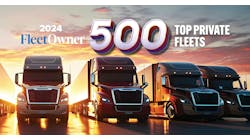Editor's note: View more recent FleetOwner 500: Top Private Fleets lists for 2020, 2021, and 2022. All FleetOwner 500 content can be found here.
While their primary business is not shipping freight across the country, private fleets remain a critical component of the trucking industry.
There are more than 200,000 companies, excluding farmers, operating private fleets in the United States based on the 2018 benchmarking survey from the National Private Truck Council (NPTC), which is holding its annual conference and exhibition here this week. These fleets account for 68% of the outbound freight and have a Dept. of Transportation recordable crash rate of 0.49 per 1 million miles driven.
Along with it’s parent company, PepsiCo, Frito-Lay operates the second largest private fleet in the U.S. and has shown a strong commitment to the environment and sustainability. Frito-Lay participated in the North American Council for Freight Efficiency (NACFE) Run on Less program to help demonstrate how the implementation of different technologies can help achieve higher levels of fuel economy, thus reducing greenhouse gas emissions, and fuel expenditures.
The company’s fleet has been an early adopter of the use of alternative fuels such as compressed natural gas (CNG) and electric vehicles, thereby enabling the fleet to reduce it diesel fuel consumption by 30% in recent years. Frito-Lay operates the largest number of all-electric vehicles in the U.S.
While a shortage of qualified drivers remains a top concern for private fleets, average salaries are $67,869. As a result, private fleets have a turnover rate of 15.4%, well below most for-hire trucking companies.
Still many private fleets, including Walmart, are taking actions to recruit and retain safe drivers. The company, which is No. 43 on this year’s list, recently announced a 1¢-per-mile pay increase and a 50¢ increase in activity pay for arrive/drop occurrences. This means Walmart drivers can earn an average of $87,500 in their first year of employment. These drivers also receive paid time off, predictable home time quarterly safety bonuses, and a safety incentive.
A survey by NPTC also showed how many of these fleets are ahead of the technology curve, with 44% reporting use of both forward- and driver-facing cameras.
Additionally, 84% of private fleets are involved in some sort of “green” initiative.
Recent steps by Tyson Foods, ranked No. 47, illustrate that green commitment. The company is in the middle of a pilot program with San Diego-based Achates Power. Tyson is testing Achates’ power opposed-posting engine, which has shown a 90% reduction in nitrous oxide and 15% savings on fuel costs. The program is projected to extend into the second quarter of 2020.
Separately, this year the company has already tested an all-electric terminal yard tractor at its Northwest Arkansas distribution center. Tyson said it is evaluating whether the vehicles reduce maintenance expenses and equipment downtime.
Looking ahead, NPTC said most private fleets expect to add equipment and haul more freight during the next five years.
“There has never been a better time to ‘sell’ the private fleet to company owners and senior executives who may not fully appreciate or underestimate the significant value which the fleet contributes to the company’s overall success,” said NPTC President Gary Petty. “Companies with private fleets benefit from constant reminders to senior executives that outsourcing their private fleet can be a perilous option, which, especially in this extreme market, could result in prohibitively expensive transportation costs, a decline in customer service, and the risk of business loss.”
This is the 16th year Fleet Owner has published this list, which ranks private fleets based on the number of trucks and tractors they operate while also identifying the industries they serve. The list is compiled by FleetSeek from a database that’s constantly being updated through a variety of channels to create the most up-to-date list possible. The data is current as of Dec. 31, 2018.
The Fleet Owner 500 is also available here as a PDF. Click the box below to view the list, which is also sortable by rank, company name, operating type, city, total vehicles, total trucks, total tractors, and total trailers. (Note to mobile users: If you do not see all the columns in this list, please ask your mobile browser to show the desktop version of the website; instructions on how to do this for iPhones is here and for Android phones is here.)



